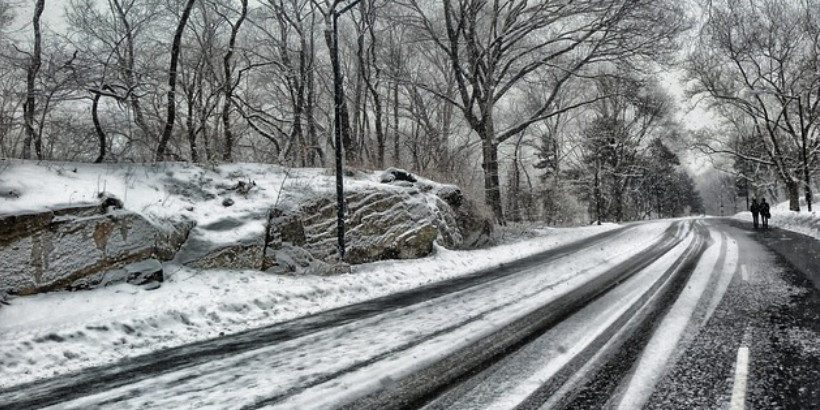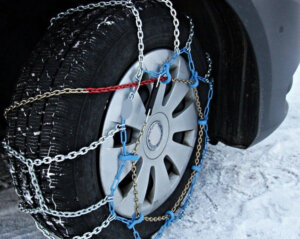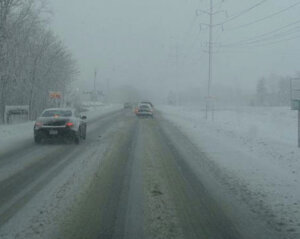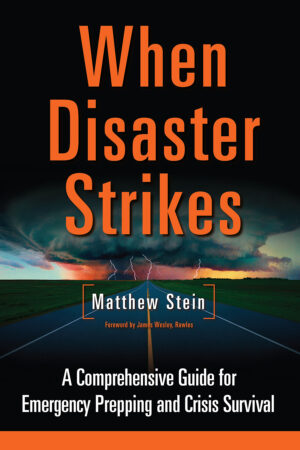Car Survival Tips for Severe Winter Weather

Now that temperatures have started to dip below freezing, it’s time to get serious about winter preparedness — especially when it comes to driving! Here are some car survival tips to help your vehicle get through the winter.
The following is an excerpt from When Disaster Strikes by Matthew Stein. It has been adapted for the web.
Every winter, thousands of people are stranded while driving in the snow. On more than one occasion, I have been overly confident in my abilities to drive in hazardous icy and snow covered roads, forgetting that I may know how to drive in the snow, but that does not mean the other guy does. When driving in winter weather, it is best to heed the old Yankee saying: “Hope for the best, but plan for the worst!”
Here are a few tips I’ve picked up over the years that, I hope, will keep you safe no matter what the road conditions look like.
Make sure that your car’s antifreeze and windshield washer fluid can handle the predicted lowest temperatures. It is both frightening and dangerous when you find yourself blinded by a slushy spray that coats your windshield, only to discover that your washer fluid is frozen and worthless. You can pick up an inexpensive plastic meter with different colored balls inside it for measuring to what temperature your car’s antifreeze is good for freeze protection.
 Carry chains and make sure they really fit your tires and that you know how to install them. It is a good idea to practice putting your chains on in broad daylight on dry pavement. It is much harder to figure these things out in the middle of a blinding snowstorm at night when you are cold and wet and lying on your belly in a foot of new snow. The night before I wrote this, I was helping a motorist around the corner who was stuck on a hill with wet snow that had packed to ice. He had a pair of brand new cable chains, but had no clue as to how to install them.
Carry chains and make sure they really fit your tires and that you know how to install them. It is a good idea to practice putting your chains on in broad daylight on dry pavement. It is much harder to figure these things out in the middle of a blinding snowstorm at night when you are cold and wet and lying on your belly in a foot of new snow. The night before I wrote this, I was helping a motorist around the corner who was stuck on a hill with wet snow that had packed to ice. He had a pair of brand new cable chains, but had no clue as to how to install them.
That particular style of cable chain was pretty near impossible to properly tighten when installing in the snow, rather than on pavement, so after spending a half hour trying to get the cable chains properly installed, we ended up towing him with a rope and a four-wheel-drive pickup. Some states outlaw tire chains, but in a dicey situation on treacherous roads, I figure it is better to be safe and use the chains than to worry about breaking a rule. If you have a set of traditional tire chains, you should also carry spare chain repair links and at least one set of chain tensioners (not for use with cable chains).
Bring along a flashlight. Very useful for flagging down cars, warning people of an accident, and an absolute must
for installing tire chains in the dark. I personally prefer a waterproof backcountry style headlamp over a standard flashlight, because it leaves my hands free and shines wherever I point my head. Have you ever tried installing tire chains by yourself while holding your flashlight in your teeth?
Carry extra food, water, and clothing, including a warm hat, mittens or gloves, and a warm jacket that preferably has a waterproof but breathable outer shell, such as one made from Gore-Tex. Make sure you have boots that are adequate for trudging through miles of snow. Tennis shoes just don’t cut it in the snow, and frozen toes are no fun!
Carry a snow scraper for clearing your windshield, a broom for brushing snow off your car, a compact shovel for digging your vehicle out of a snow bank, and sand or a piece of burlap for traction in case your wheels become stuck.
Check the weather forecast and updated road conditions.
Stash a spare key on your car. Motorists sometimes get locked out of their vehicle while installing tire chains. I like to bring along a waterproof poncho, tarp, or rain jacket and rain pants for lying in the slush while installing tire chains.
To Stay in Your Car or Abandon It?
 People ask me this question, and I tell them there is no single right answer, though there is an optimal answer for each situation. Assuming you are stuck either in traffic that has come to a stop, or along the side of a road, here are a few thoughts and guidelines:
People ask me this question, and I tell them there is no single right answer, though there is an optimal answer for each situation. Assuming you are stuck either in traffic that has come to a stop, or along the side of a road, here are a few thoughts and guidelines:
-
Is your car in a dangerous position where there is a significant chance you may be run into by another car? If so, abandon your car and relocate yourself to some nearby place where you aren’t in danger!
-
How much gasoline do you have in your tank? Do you have enough spare clothing to stay warm inside your car without running the engine? If not, and you may be stuck for a long time, ration your gasoline by turning your car on for a few minutes at a time to warm the heater, then turn it off again. In my part of the country (High Sierras near Lake Tahoe), major freeways over mountain passes can stay closed for days, and I have been stopped in traffic for eight hours while waiting for accidents to clear. At times like these, it is common for motorists to run out of gas while idling to keep their car heaters going.
-
What is your footwear like? Are you equipped to walk for miles in the snow and spend the night outside if necessary?
-
If your clothing is not really adequate for spending long hours outside in the snow, is there enough passing traffic to hitch a ride to a nearby town, or is all traffic stopped and the road shut down? If your chances of hitching a ride are slim, and your car is parked in a safe spot, you are probably better off staying inside your vehicle.
-
In a desperate situation, lacking suitable boots for snow country travel, you could use a knife to slice up your car seat cushions to make strips of thick insulation that could be wrapped around your feet and lower legs to provide the insulation needed to protect your feet from freezing while trudging for miles through the snow. Wires from your car could be twisted until they break to provide cordage for tying the insulation around your feet and legs. If you lacked a knife, a piece of plastic or metal trim could be pried off your car, or perhaps broken from an item like your glove box, to provide a sharp edge for slicing your seat cushions into usable pieces of insulated fabric. Also, the mirrors of your car could be broken to provide a sharp piece of glass, though it would not do any good to break the windows, since they are made from tempered safety glass and would shatter into tiny unusable pieces.
Recommended Reads
Prepping 101: Everything You Need for a Grab-n-Go Survival Kit
Recent Articles
Garlic mustard: while known as “invasive,” this plant can be consumed in its entirety and has great nutritional value. Plus, the garlic-flavor is a perfect addition to any recipe that calls for mustard! The following are excerpts from Beyond the War on Invasive Species by Tao Orion and The Wild Wisdom of Weeds by Katrina…
Read MoreMany know the effects of catnip on our feline friends, but few realize that catnip has medicinal effects for humans. From stomach aches to reducing fevers, catnip is a versatile herb with many benefits. The next time you grow this plant for your cat you may end up taking a few cuttings for yourself! The…
Read MoreWhether you’re looking to replace your end-of-the-day cocktail, relax before bed, or want something new to add to your tea, this non-alcoholic mocktail syrup base will do the trick. Delicious and all-natural, take a sip of this nightcap mocktail and feel your troubles melt away. The following is an excerpt from Herbal Formularies for Health…
Read MoreSurprisingly, medicine can actually be delicious. This anti-inflammatory smoothie uses natural (and tasty!) ingredients to help reduce inflammation caused by any number of circumstances. The following is an excerpt from Herbal Formularies for Health Professionals, Volume 4 by Jill Stansbury. It has been adapted for the web. RECIPE: Ginger and Pineapple Anti-Inflammatory Smoothie This is an all-purpose…
Read MoreWant to witness the magic of the mini-forest? When you practice The Miyawaki Method, a unique approach to reforestation, you’ll see an empty lot or backyard transform into a biodiverse forest before your very eyes. The following is an excerpt from Mini-Forest Revolution by Hannah Lewis. It has been adapted for the web. Photo Credit:…
Read More







